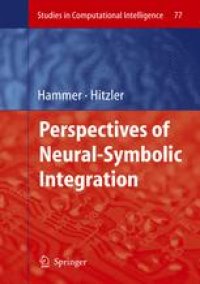
Ebook: Perspectives of Neural-Symbolic Integration
- Tags: Appl.Mathematics/Computational Methods of Engineering, Artificial Intelligence (incl. Robotics)
- Series: Studies in Computational Intelligence 77
- Year: 2007
- Publisher: Springer-Verlag Berlin Heidelberg
- Edition: 1
- Language: English
- pdf
The human brain possesses the remarkable capability of understanding, interpreting, and producing language, structures, and logic. Unlike their biological counterparts, artificial neural networks do not form such a close liason with symbolic reasoning: logic-based inference mechanisms and statistical machine learning constitute two major and very different paradigms in artificial intelligence with complementary strengths and weaknesses. Modern application scenarios in robotics, bioinformatics, language processing, etc., however require both the efficiency and noise-tolerance of statistical models and the generalization ability and high-level modelling of structural inference meachanisms. A variety of approaches has therefore been proposed for combining the two paradigms.
This carefully edited volume contains state-of-the-art contributions in neural-symbolic integration, covering `loose' coupling by means of structure kernels or recursive models as well as `strong' coupling of logic and neural networks. It brings together a representative selection of results presented by some of the top researchers in the field, covering theoretical foundations, algorithmic design, and state-of-the-art applications in robotics and bioinformatics.
The human brain possesses the remarkable capability of understanding, interpreting, and producing language, structures, and logic. Unlike their biological counterparts, artificial neural networks do not form such a close liason with symbolic reasoning: logic-based inference mechanisms and statistical machine learning constitute two major and very different paradigms in artificial intelligence with complementary strengths and weaknesses. Modern application scenarios in robotics, bioinformatics, language processing, etc., however require both the efficiency and noise-tolerance of statistical models and the generalization ability and high-level modelling of structural inference meachanisms. A variety of approaches has therefore been proposed for combining the two paradigms.
This carefully edited volume contains state-of-the-art contributions in neural-symbolic integration, covering `loose' coupling by means of structure kernels or recursive models as well as `strong' coupling of logic and neural networks. It brings together a representative selection of results presented by some of the top researchers in the field, covering theoretical foundations, algorithmic design, and state-of-the-art applications in robotics and bioinformatics.
The human brain possesses the remarkable capability of understanding, interpreting, and producing language, structures, and logic. Unlike their biological counterparts, artificial neural networks do not form such a close liason with symbolic reasoning: logic-based inference mechanisms and statistical machine learning constitute two major and very different paradigms in artificial intelligence with complementary strengths and weaknesses. Modern application scenarios in robotics, bioinformatics, language processing, etc., however require both the efficiency and noise-tolerance of statistical models and the generalization ability and high-level modelling of structural inference meachanisms. A variety of approaches has therefore been proposed for combining the two paradigms.
This carefully edited volume contains state-of-the-art contributions in neural-symbolic integration, covering `loose' coupling by means of structure kernels or recursive models as well as `strong' coupling of logic and neural networks. It brings together a representative selection of results presented by some of the top researchers in the field, covering theoretical foundations, algorithmic design, and state-of-the-art applications in robotics and bioinformatics.
Content:
Front Matter....Pages I-XIII
Front Matter....Pages 1-5
Kernels for Strings and Graphs....Pages 7-22
Comparing Sequence Classification Algorithms for Protein Subcellular Localization....Pages 23-48
Mining Structure-Activity Relations in Biological Neural Networks using NeuronRank....Pages 49-65
Adaptive Contextual Processing of Structured Data by Recursive Neural Networks: A Survey of Computational Properties....Pages 67-94
Markovian Bias of Neural-based Architectures With Feedback Connections....Pages 95-133
Time Series Prediction with the Self-Organizing Map: A Review....Pages 135-158
A Dual Interaction Perspective for Robot Cognition: Grasping as a “Rosetta Stone”....Pages 159-178
Front Matter....Pages 179-182
SHRUTI: A Neurally Motivated Architecture for Rapid, Scalable Inference....Pages 183-203
The Core Method: Connectionist Model Generation for First-Order Logic Programs....Pages 205-232
Learning Models of Predicate Logical Theories with Neural Networks Based on Topos Theory....Pages 233-264
Advances in Neural-Symbolic Learning Systems: Modal and Temporal Reasoning....Pages 265-282
Connectionist Representation of Multi-Valued Logic Programs....Pages 283-313
Back Matter....Pages 315-319
The human brain possesses the remarkable capability of understanding, interpreting, and producing language, structures, and logic. Unlike their biological counterparts, artificial neural networks do not form such a close liason with symbolic reasoning: logic-based inference mechanisms and statistical machine learning constitute two major and very different paradigms in artificial intelligence with complementary strengths and weaknesses. Modern application scenarios in robotics, bioinformatics, language processing, etc., however require both the efficiency and noise-tolerance of statistical models and the generalization ability and high-level modelling of structural inference meachanisms. A variety of approaches has therefore been proposed for combining the two paradigms.
This carefully edited volume contains state-of-the-art contributions in neural-symbolic integration, covering `loose' coupling by means of structure kernels or recursive models as well as `strong' coupling of logic and neural networks. It brings together a representative selection of results presented by some of the top researchers in the field, covering theoretical foundations, algorithmic design, and state-of-the-art applications in robotics and bioinformatics.
Content:
Front Matter....Pages I-XIII
Front Matter....Pages 1-5
Kernels for Strings and Graphs....Pages 7-22
Comparing Sequence Classification Algorithms for Protein Subcellular Localization....Pages 23-48
Mining Structure-Activity Relations in Biological Neural Networks using NeuronRank....Pages 49-65
Adaptive Contextual Processing of Structured Data by Recursive Neural Networks: A Survey of Computational Properties....Pages 67-94
Markovian Bias of Neural-based Architectures With Feedback Connections....Pages 95-133
Time Series Prediction with the Self-Organizing Map: A Review....Pages 135-158
A Dual Interaction Perspective for Robot Cognition: Grasping as a “Rosetta Stone”....Pages 159-178
Front Matter....Pages 179-182
SHRUTI: A Neurally Motivated Architecture for Rapid, Scalable Inference....Pages 183-203
The Core Method: Connectionist Model Generation for First-Order Logic Programs....Pages 205-232
Learning Models of Predicate Logical Theories with Neural Networks Based on Topos Theory....Pages 233-264
Advances in Neural-Symbolic Learning Systems: Modal and Temporal Reasoning....Pages 265-282
Connectionist Representation of Multi-Valued Logic Programs....Pages 283-313
Back Matter....Pages 315-319
....